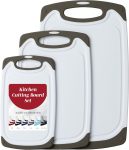
The Ultimate Guide to Choosing the Best Cutting Boards for Your Kitchen in 2025
When it comes to essential kitchen tools, a quality cutting board is often overlooked despite being one of the most frequently used items in any home kitchen. Whether you’re a professional chef or a home cooking enthusiast, choosing the right cutting board can make a significant difference in your food preparation experience, knife longevity, and overall kitchen safety.
Why Your Choice of Cutting Board Matters
A good cutting board serves as the foundation for all your food prep work. It protects your countertops, preserves your knife edges, and provides a stable, hygienic surface for chopping, slicing, and dicing. With so many materials and options available today, selecting the right cutting board can feel overwhelming.
Types of Cutting Board Materials: Pros and Cons
Wood Cutting Boards: The Traditional Choice
Advantages:
- Naturally antimicrobial properties
- Gentle on knife edges
- Durable and long-lasting with proper care
- Attractive appearance that complements kitchen décor
- Self-healing surface that closes small cuts over time
Disadvantages:
- Requires regular maintenance and oiling
- Can harbor bacteria if not properly cleaned
- More expensive upfront cost
- Heavy and bulky storage
Best Wood Types:
- Maple: Hard, dense wood that’s gentle on knives
- Walnut: Beautiful grain patterns with good durability
- Cherry: Attractive reddish color that darkens with age
- Bamboo: Technically a grass, eco-friendly and lightweight
Plastic Cutting Boards: The Practical Option
Advantages:
- Dishwasher safe and easy to sanitize
- Lightweight and easy to store
- Affordable and replaceable
- Available in multiple colors for food safety coding
- Non-porous surface resists staining
Disadvantages:
- Can dull knives faster than wood
- Develops deep grooves that harbor bacteria
- Less aesthetically pleasing
- Environmental concerns with disposal
- Can become slippery when wet
Bamboo Cutting Boards: The Eco-Friendly Alternative
Advantages:
- Sustainable and renewable resource
- Naturally antimicrobial
- Lighter than traditional hardwood
- Attractive grain patterns
- More affordable than premium hardwoods
Disadvantages:
- Can be very hard on knife edges
- Quality varies significantly between manufacturers
- Some are made with harmful adhesives
- Can develop splinters over time
Glass and Stone Cutting Boards: The Hygienic but Harsh Choice
Advantages:
- Completely non-porous and hygienic
- Easy to clean and sanitize
- Heat resistant
- Stain resistant
Disadvantages:
- Extremely hard on knife edges
- Noisy during use
- Can chip or break if dropped
- Slippery surface can be dangerous
- Not recommended for regular knife work
Size Matters: Choosing the Right Dimensions
Standard Cutting Board Sizes
Small (8″ x 10″): Perfect for:
- Cutting fruits and garnishes
- Small kitchen spaces
- Bar prep work
- Travel or RV kitchens
Medium (12″ x 16″): Ideal for:
- Daily home cooking
- Chopping vegetables
- Most kitchen tasks
- Standard counter spaces
Large (15″ x 20″ or larger): Best for:
- Serious home cooks
- Preparing large meals
- Professional kitchens
- Carving roasts and large proteins
Thickness Considerations
- Thin boards (1/2″ to 3/4″): Lightweight but may warp over time
- Medium thickness (3/4″ to 1.5″): Good balance of stability and weight
- Thick boards (1.5″ or more): Most stable but heavier and more expensive
Food Safety: The Two-Board System
Professional kitchens and food safety experts recommend using separate cutting boards for different food types to prevent cross-contamination:
Board #1: Raw Proteins
- Use for raw meat, poultry, and seafood
- Choose a plastic board for easy sanitization
- Replace when deeply grooved
Board #2: Ready-to-Eat Foods
- Use for fruits, vegetables, bread, and cooked foods
- Wood or high-quality plastic works well
- Keep in pristine condition
Top Cutting Board Recommendations for 2025
Best Overall: Premium Hardwood Cutting Board
For serious home cooks who want the best cutting experience, a high-quality hardwood board is unmatched. Look for:
- End-grain construction for knife protection
- Minimum 1.5″ thickness for stability
- Rubber feet to prevent sliding
- Finger grooves or handles for easy lifting
Best Value: BPA-Free Plastic Cutting Board Set
Based on the Amazon product shown in your images, plastic cutting board sets offer excellent value:
- Multiple sizes for different tasks
- Dishwasher safe convenience
- Non-slip edges for safety
- Juice grooves to contain liquids
- Color coding for food safety
Key Features to Look For:
- BPA-free construction
- Non-slip backing or feet
- Juice grooves around the perimeter
- Multiple sizes in one set
- Dishwasher safe materials
Best for Small Kitchens: Bamboo Cutting Board
For apartment dwellers and those with limited storage:
- Lightweight and easy to store
- Naturally antimicrobial
- Eco-friendly choice
- Good balance of durability and price
Cutting Board Maintenance Tips
For Wood Boards:
- Clean immediately after use with warm soapy water
- Oil monthly with food-grade mineral oil or board conditioner
- Sand lightly if surface becomes rough
- Store upright to allow air circulation
- Never soak or put in dishwasher
For Plastic Boards:
- Wash in dishwasher on high heat for sanitization
- Replace when grooved beyond easy cleaning
- Use bleach solution occasionally for deep cleaning
- Check for warping and replace if severe
- Avoid extreme heat that can cause melting
Common Cutting Board Mistakes to Avoid
- Using glass or stone for knife work – destroys blade edges
- Not cleaning properly – allows bacteria growth
- Using the same board for all foods – cross-contamination risk
- Ignoring maintenance – shortens board lifespan
- Choosing based on looks alone – function should come first
Special Considerations for Different Cooking Styles
For Meal Preppers:
- Large surface area is essential
- Easy-clean materials save time
- Multiple boards for batch cooking
- Consider plastic for easy sanitization
For Knife Enthusiasts:
- End-grain wood is non-negotiable
- Avoid bamboo and plastic
- Invest in premium hardwoods
- Maintain properly to protect investment
For Small Households:
- Medium-sized board handles most tasks
- Over-the-sink boards maximize counter space
- Reversible boards offer versatility
- Storage solutions matter
Environmental Considerations
As sustainability becomes increasingly important, consider:
- Bamboo: Fast-growing and renewable
- FSC-certified wood: Responsibly sourced
- Recycled plastic: Gives new life to waste materials
- Local materials: Reduces transportation impact
Budget-Friendly Options That Don’t Compromise Quality
You don’t need to spend a fortune for a good cutting board:
- IKEA bamboo boards: Excellent value for basic needs
- Restaurant supply stores: Professional quality at wholesale prices
- Plastic board sets: Maximum versatility per dollar
- Local woodworkers: Custom boards at competitive prices
When to Replace Your Cutting Board
Replace your cutting board when:
- Deep grooves that can’t be cleaned easily
- Persistent odors that won’t wash away
- Warping or cracking that affects stability
- Staining that indicates bacterial growth
- Any signs of mold or deterioration
Final Recommendations
For most American home kitchens, we recommend:
- Primary board: Medium-sized hardwood (maple or walnut) for daily vegetable prep
- Secondary board: Plastic board specifically for raw meats
- Specialty board: Small bamboo board for fruits and quick tasks
This three-board system provides maximum food safety, knife protection, and cooking versatility while remaining practical for most home kitchens.
Conclusion
Choosing the right cutting board is an investment in your kitchen’s functionality and your cooking experience. Whether you opt for the traditional appeal of hardwood, the practicality of plastic, or the sustainability of bamboo, the key is matching your choice to your cooking style, maintenance preferences, and budget.
Remember that a quality cutting board, properly maintained, can last for decades and make every meal preparation more efficient and enjoyable. Take time to consider your specific needs, and don’t hesitate to invest in quality – your knives and your cooking will thank you.
What type of cutting board do you prefer in your kitchen? Share your experiences in the comments below, and don’t forget to check out our other kitchen essential guides for more cooking tips and product recommendations.




